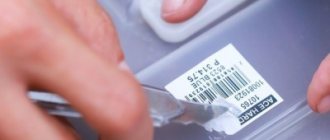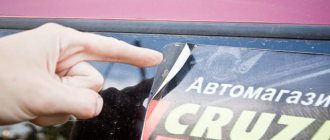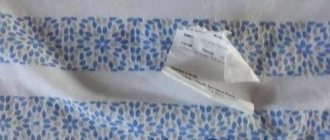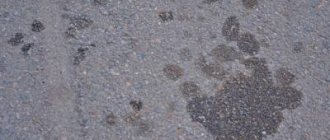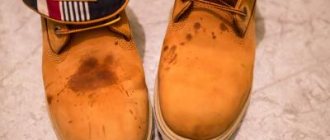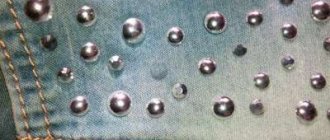How to remove a sticker from your phone?
You should very carefully heat the sticker with moderately warm air from a hair dryer (so that the glue softens), and then carefully, slowly remove it using a plastic card. If a hairdryer doesn't help, you can lightly moisten the sticker with acetone or nail polish remover.
Interesting materials:
What is the correct way to speak with your fingers or with your fingers? What is the correct way to say a pair of socks or a pair of socks? How to say pair of scissors correctly? What is the correct way to say pizzeria or pizzeria? How to speak correctly on a bridge? How to speak correctly upon arrival? How to say pallet or pallet correctly? How to speak Poles correctly? How to say put it down correctly? What is the correct way to say put it on the table or put it on the table?
Stickers on cars and household appliances
To remove traces of labels or tape from a car, use special car cleaners. Alternatively, you can warm up the machine panel with a hairdryer and carefully scrape off the label.
By the way, at gas stations, stickers are removed using a hair dryer. Another option is to use steam or boiling water to heat the problem area of the metal, after which the adhesive composition will melt and it will be easy to remove marks.
Traces of adhesive tape on a refrigerator, stove, washing machine, microwave or other household appliances can be removed using vegetable oil, a hair dryer, a school eraser or special cleaning products. By the way, you can stick another one on top of the tape and tear it off sharply. Then the old tape will come off along with the old one.
To clean household appliances, use methods for plastic products, since plastic is mainly used in the manufacture of these items. A regular soap solution is perfect for washing.
For more information on how to clean and renew plastic, return the original color to plastic products and eliminate yellowness, see the link.
We wipe away traces with professional compounds
Effective solvents for glue. Remove traces of it from different surfaces. The composition of the preparations most often includes natural ingredients. Thanks to this, they do not harm the base. Here are a few such tools:
- "Antiscotch". Universal composition. Removes the most stubborn stains from any surface.
- Fine Glass. Preparation for glass. In addition, it cleans ceramics, plastic and metal well.
- Scotch Remover with citrus oils. Removes any adhesive pastes, resins, tar.
- Liqui Moly. A universal preparation based on natural ingredients.
Instagram probka_grodno
All of these products are effective and easily remove label residues. Their main disadvantage is their high price.
Special means
In a situation where traditional methods have proven to be ineffective in the fight against sticky marks from stickers, special means will come to the rescue.
TOP 3 most effective drugs:
Liqui Moly Sticker Mark Remover is a universal product that helps you quickly deal with sticker marks on any surface.
Directions for use: spray on the stain and leave for five minutes, after removing a particle of glue with a damp sponge. The average cost is 570 rubles.- Prosept tape and sticker cleaner is an aerosol that helps get rid of sticker marks in a matter of minutes). Directions for use: spray the mixture onto the sticky mark, wait two minutes, wipe the surface with a damp cloth. The average cost of Prosept aerosol is 270 rubles.
- Anti-adhesive sticker remover is a universal means of dealing with sticky glue stains on any surface. Directions for use: Spray the aerosol onto the stain and leave for three minutes. Afterwards, the sticky mark can be easily removed with a rubber spatula. The average cost of Antiscotch is 160 rubles.
Before using a special chemical, you must carefully study the instructions for use.
How to get rid of glue on a jar?
Hello! First, remove the label itself, wet the residue with water and remove it from the surface. Next, use detergent, glass cleaner, or alcohol. Apply to the remaining glue, wait a while, then wipe off any remaining traces.
Interesting materials:
How to choose a chicken that doesn't lay eggs? How to choose an apartment on the sunny side? How to choose blades for figure skating? How to choose the best seat on the bus? How to choose the best pruning shears? How to choose the best type of veal? How to choose skis based on height and weight? How to choose a guitar pick? How to choose chalk for a blackboard? How to choose a melody for a Beeline beep?
Mechanical cleaning by hand
Wipe off the glue from the sticker by hand, perhaps if it is relatively fresh and can be removed without much difficulty.
- Use three hands to apply the adhesive layer, rolling it into small spherical formations (pellets).
- Once a satisfactory result is achieved, wash off the residue using conventional means.
- In case of incomplete removal of contaminants, we use the methods described below.
Vegetable oil
This product is found in almost every kitchen, and with its help it is possible to remove glue residue from surfaces that do not absorb oil, such as bottles or ceramic dishes. Olive, flaxseed or refined sunflower are suitable. Sequencing:
- Cover the remaining sticker with an even layer of oil.
- We wait a couple of minutes for the paper and glue to become saturated, after which it is easier to remove them.
- We scrape off the softened fragments with any suitable object - a knife, a plastic card or fingernails.
- Anything left can be washed with hot water and dish gel.
If suddenly there is no oil, but there is mayonnaise, follow the above procedure with its help.
Alcohol
Any alcohol-containing products will do: vodka, cologne, deodorant. The higher the concentration, the more productive the process will be.
- Wet a cloth or napkin in alcohol.
- Wipe off the sticky residue.
- We wash away the remains.
The method should be used with caution. Not every surface is able to withstand the effects of alcohol-containing mixtures without consequences. To avoid deformation of the coating being treated, conduct a preliminary test on an inconspicuous piece of material.
Masking tape
A wedge-to-wedge method. It will only work in cases with fresh, not strongly glued labels. In addition to masking tape, any other high-quality tape will do.
- Carefully apply adhesive tape to the remaining label residue.
- Hold part of the tape firmly with your hand.
- With a sharp movement we try to tear off the tape and the fragments stuck to it.
- We repeat the procedure until a positive result is achieved.
Table vinegar
This food additive will remove old, dried traces of stickers, labels, stickers and any types of tape. The surface being treated is not of fundamental importance, just as vinegar is not an aggressive cleaning liquid.
- Apply vinegar concentrate (11%) to the area to be cleaned.
- We wait 5 minutes for the paper and glue to soften.
- Use a thin object to remove the softened marks.
- Wipe with a damp soapy sponge.
- We look at the result and, if necessary, repeat the operation.
Combustible mixtures
Kerosene, refined gasoline or lighter fluid will remove all known types of adhesive papers and films from glass or similar surfaces.
- Wet a cloth or napkin with gasoline.
- Apply a thin layer of adhesive contamination.
- Wait 2 minutes, then wipe with the same cloth until the stain disappears completely.
- Afterwards, you can wash it off with warm soapy water to remove the smell, if any.
The solvent properties of the above mixtures make their use undesirable on a number of surfaces, for example, products painted with alkyd varnishes or paints and some types of plastic.
Heat treatment with a hairdryer
The method is suitable for removing old stains from metal and many other surfaces.
- Warm up the stain with a hairdryer.
- Scrape off the softened substance.
- Wet a cloth or sponge with sunflower oil.
- Apply oil, wait 5 minutes, wipe with the same cloth.
- Wash off with soapy water and then rinse.
The procedure does not require exposure to high temperatures, so a hair dryer will be as effective as its construction counterpart. If you use the latter, you should not heat the items to be cleaned too much, so as not to spoil them. Particular care should be taken when removing from plastic or painted products. Plastic deforms when exposed to hot air, and varnish or paint swells. Actually, its removal is one of the main areas of use of construction hair dryers.
Wet wipes
Very minor adhesive formations can be removed with ordinary damp wipes. The method is quite simple, but sometimes it takes a lot of time if you tackle large-scale pollution. All you need to do is take a damp cloth and rub it on the stain until it disappears.
Acetone and hair dryer
A combined method using a solvent and heat treatment will help you get rid of the price tag on a paper surface.
- Warm up the label with a hairdryer.
- We remove dirt mechanically with a plastic card or other suitable object.
- We wipe off the remaining glue fragments with a cotton swab soaked in acetone (there should not be a lot of liquid, otherwise the paper will get wet or marks will remain on it).
In the absence of a solvent, nail polish remover will be no less effective.
Melamine sponge
From hard surfaces, such as laminate or wood furniture, glue can be easily removed with this cleaning accessory. The principle of operation is comparable to an eraser and is as follows:
- Wet the contaminated surface with cold water.
- Use three sponges until the result is acceptable.
Melamine sponges are toxic (or so the manufacturers of competing products claim), so contact with food and objects with which these products may come into contact should be avoided.
Detergent
Dish gel will help clean glue stains on clothes and upholstered furniture. To achieve the desired result, you must follow the sequence of actions described below:
- We moisten the problem area and apply a gel-like product to it.
- We wait a couple of minutes until the label gets wet, then wipe it off.
- If clothes were cleaned this way, they will have to be washed completely.
Steam cleaning
The method is suitable for moisture-resistant materials that will not be adversely affected by the temperature of boiling water.
- Place the kettle on the stove and bring it to a boil (using an electric kettle is not effective).
- We bring the surface to be cleaned to the steaming spout (it is important to warm it all evenly).
- After 2-3 minutes, you can remove the remaining sticker, and then wash everything with soapy water.
School eraser
It will do the job perfectly if the sticker is relatively fresh and does not cover large areas. We proceed as follows:
- Wet the contaminated area with a damp sponge or cloth.
- We wipe it with a rough cloth, let it dry and erase everything that remains with an eraser.
It may not be possible to remove the label completely the first time, in which case we repeat the procedure.
Lemon
A regular citrus fruit, available at any grocery store, will replace harsh liquids and be just as effective.
- Cut a piece of lemon, quite large, to clean the contaminated area.
- Rub the surface of the cut onto the dirt and leave for a couple of minutes.
- Scrape off the softened accumulations, then rinse off the residue with warm water.
If fresh lemons are not available, an aqueous solution of powder concentrate will do. You will have to moisten it not with a piece of fruit, but with a napkin or sponge soaked in liquid.
